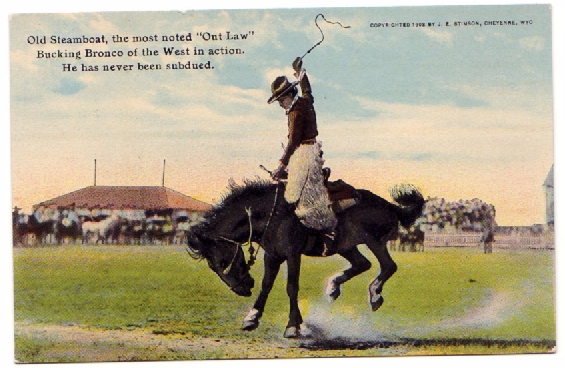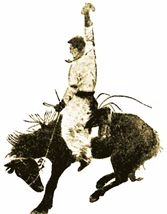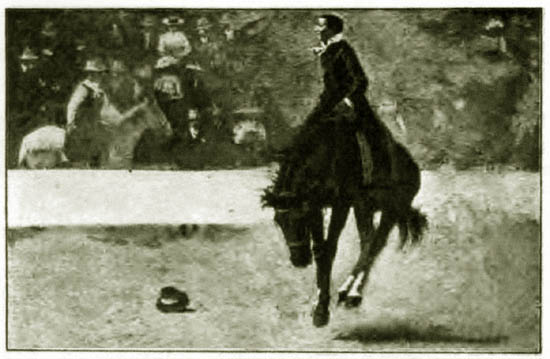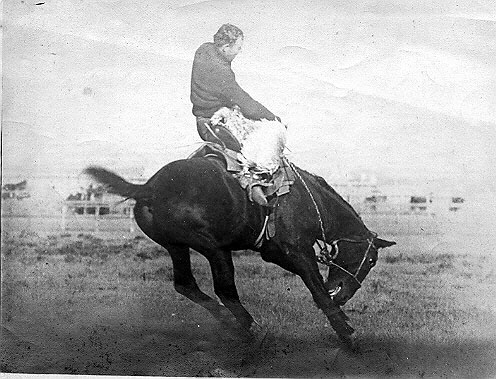|

Dick Stanley on Steamboat, 1908, photo by J.E. Stimson. Web Image Copyright G.B. Dobson, 2001. Photograph
may not be reproduced or used on-line without express permission of copyright holder.
For discussion of Stimson see Cheyenne.
The horse, Steamboat, is popularly regarded as the horse depicted on the Wyoming license plates and as
the logo for the University of Wyoming. Steamboat was born near Bosler on the Two Bar Ranch and for a period of time belonged
to John C. Coble. For more on Coble see Tom Horn.
Steamboat appeared in various rodeos between 1901 and 1914.
The rider, Dick Stanley appeared out of nowhere to enter the 1908 contest. F. H. Barrow, editor of the Wyoming Industrail Journal, writing in The
Pacific Monthly, 1909 "When Stanley Scratched Steamboat," quoted C. B. Irwin, owner of Steamboat, as saying,
"Nobody knows 'im. Jes' slipped in here las' night an' say he's a buster here to play fer the chunk. Says he's from Portlan', er som'ers out that way."
Nevertheless, Irwin's assessment was that Stanley, even though unknown, had a good chance of beating Clayton Danks, the favorite, "Fer he's that light he kin stick a hoss like a
deer fly."
 A. J. "Stub" Farlow, riding Deadman. A. J. "Stub" Farlow, riding Deadman.
[Some question may exist as to identification of photo. Compare with postcard of
Eddie McCarty on Silver City on the next page.]
Barrow, using cowboy dialect which he attributed to ""Snake River Sam," described Stanley:
He's a litte, thin, pale faced lookin' cuss an' that sorry lookin' ye'd pick 'im out for
a short yearlin' comin' out of a hard winter. He's that skinny I reckon a mangy canner'd look like a corn-fed beef critter, by way o' comparison an' he
stands kinda humped up like a July calf in a March blizzard. He wears a big black hat, a
flamin' purple shirt, an' just pants with the legs stuck in 'is boots.
He's got a pair o'big silver spurs an' he's holdin' a pair o' fancy Injun gloves with
beads all over 'em an long fringe a-hangin' down. No chaps -- jus' dressed like an cowpinch what come down to see
the fun an' have a good time.
"Snake River Sam" continues in his description:
Wiry look' sort of a geezer -- nervous as a two-year-ol' with her fir' calf. He's got a little sickly lookin' mustache an' a goatee, an' wears his hair
long same's Buffalo Bill."
The famed "muckraker" Lincoln Steffens (1866-1936) in an
article in McClure's Magazine, November, 1902, described Steamboat in
action at the 1902 Mountain and Plains Festival at Denver:
A big, clumsey looking black horse came in, and everybody cheered. The horse had all
the marks of a plug, and he trotted in like a work horse. "Steamboat" they call him, in the tone of
a man speaking the name of some delicious food.
"To the right," said Mr. [J. M.] Kuykendall. "He is to be kept for [Thad] Sowder [the previous year's champion of the
World] on the last day."
And it was explained that this horse was a gentle horse to saddle, let his man on, then bucked,
twisting, "sun fishing," and pounding the earth, or jumping round and round. He had won the prize for the best, i.e. the worst, horse on Frontier
Day at Cheyenne.
"Oughtt to let [Thomas] Minor from Idaho have him," said a cowboy. "We want sure to find out
about him."
"But the champion ought to have the best horse; he rides once, and out to have every change to win. Beside, you want to
know about him too, don't you? You don't think he will get it, do you?"
 Thomas Minor on Steamboat, 1902 Mountain and Plains Festival, Denver
Thomas Minor on Steamboat, 1902 Mountain and Plains Festival, Denver
Thus, it was that after the riders were eliminated down to the final two, Thad Sowder and Thomas Minor, each rode (or rather attempted to ride) Steamboat and
another horse from Coble's stable, Deadeasy. Steffens described Sowder's ride:
"Bring out Steamboat," called Mr. Kuykendall. Sowder is to ride him."
The four cowboys looked up as Sowder rode in on his show horse. the horse pranced to the music, but the rider was
modest and flushed. There was no swagger about him; only earnest preoccupation.
"Maybe he can ride," they said. "if he can, let him win. He's the best man of the two, anyway."
[Harry] Brennen [of Sheridan, Wyoming] got up, went over to Sowder, and when the
champion dismounted and had his saddle off, ready for the bucker, Brennen said to him:
Sowder, I hear you draw Steamboat, I saw him back at Cheyenne, and he can sure buck. But I tell
you this, he bucks high and he lands hard, but he goes mostly ahead. When he turns, he turns mostly to the
left. Anyhow, I never saw him turn no other way."
"I'll remember," said Sowder, and as Brennen slouched off to the bunch, the champion looked after him
with as much gratitude in his face as a man can express in a look.
Steamboat trotted in, took the saddle quietly, and when ready, Sowder turned for the word. The judges waved to
mount, and the clean limbed fellow rose slowly cautiously, into the saddle, his eyes on the horse's head. Steamboat hesitated a
moment, then went right up into the air; he hunched his back, bucked high and landed hard. Then he pitched, "mostly ahead." The
rider sat easily, leaning a little to the left, and when the big black "turned, he turned to the left," Sowder going with
him. It was as if every move of the horse were anticipated by the man. There had been
nothing like this. The crowd arose to cheer as the horse straightened out for more pitching, and the judges yelled like
cowboys when, the horse wheeling again, with high bucks to the left, found the rider before him.
The next day, Minor and Sowder again competed, this time Sowder on Deadeasy and Minor on Steamboat. Sowder was announced the winner. Minor took it with
a certain lack of grace: "Sowder," he said, "you're no rider; not with me. I challenge you to ride me again."
Sowder looked down, then up, flushed. "Minor," he said very slowly, very steadily, "if you'd a won. I'd a said you were the
champion of the world. But you didn't. I did. And since you're talking this way, I'll say right now
that there's two mn better than you."
"You and who?"
"Frank Stone and Harry Brennen."

Thad Sowder on Steamboat, Denver, 1902. Drawing by F. M. DuMond from a photograph.
Two years later, Brennen won the title at Cheyenne's Frontier Day riding Steamboat. Brennan was noted for generosity. Candy Vyvey Moulton and Flossie Moulton in their
Steamboat, Legendary Bucking Horse and the Cowboys Who Tried to Tame Him, High Plains Press, Glendo, 1992, relate that on one occasion after winning
a rodeo championship, Brennen gave Minor half his purse. Sowder did not compete in 1903. The last time he rode was in
1905. He died in 1931 suffering from periodic bouts of paralysis as a result of injuries received in broncho contests.

Harry Brennen, Denver, 1902. Drawing by H. R. Poore from a photograph.
But the true Champion of the World was Steamboat.
After John Coble sold out, he donated Steamboat to the Cheyenne Elks Lodge from whom Charley Irwin acquired the horse.
Steamboat contracted
blood poisoning in 1914 as a result of running into a barbed wire fence when frightened by an
electrical storm. Steamboat was inducted into the Pro-Rodeo Hall of Fame in 1979. Steamboat supposedly was
named because of the resemblance of his snorting to the sound of a steamboat whistle.
Some debate exists, however, as to whether the bucking horse and rider logo is in reality based on
Steamboat. It has also been contended that the rider is Albert Jerome "Stub" Farlow of Lander. See 1913 photo above
right. The University of Wyoming believes that its version of the Bucking Horse and
Rider was taken from the next photo taken at the Albany County Fair Grounds.
It has also been argued that the logo is not based on any particlar horse or rider.

Guy Holt on Steamboat, Laramie, 1903, photo by B. C. Buffum. Photo courtesy of and copyrighted by Ben and Mary Sue Henszey.
[Writer's note: The Denver Public Libray has another copy of the same photo on its website indicating that the
rider is Guy Edward Holt winning the Worlds Championship with the photo taken at Steamboat Springs, Routt County, Colorado.
Other photos of the Steamboat Springs rodeo grounds from the same period reflect a distinct background of
mountains, which are missing in the above photo. Frontier Days' archives indicate that Guy Holt won the
1903 championship. Thus, the identification of the photo being taken at Laramie may be in error. The photo may have
been taken at Cheyenne.]
As indicated in the
upper photo, it is popularly assumed that Steamboat was never successfully ridden. The assumption is, however,
not true. The horse was twice ridden in the 1908 competition, first by Clayton Danks, winner of the
1904 steer roping event and the 1907 saddle bronc contest, see stereopticon view next page. Steamboat was then ridden the next day
by Dick Stanley who used no stirrups, thus winning the
event. Stanley, however, did not stay in Cheyenne long enough to pick up his
championship saddle, but instead inexplicably left town.

Kid Moore on Steamboat, Irwin Brothers Wild West Show, Cheyenne, 1911, photo by J. Shimitiz.
Web scan copyright G. B. Dobson, 2003.
As indicated by the Daily Leader, Stanley was ostensibly from Oregon where he and his brother
operated a wild west show, The Stanley Bros. Congress of Roughriders. Stanley, with a goatee and fringed
clothing, looked much like a very young Buffalo Bill. Indeed, notwithstanding that
he was not yet 30, Stanley sometimes used the title "Colonel" in his show. Among those who received their start with
the Stanley Brothers were western movie star Edmund Richard "Hoot" Gibson
(1892-1962) and silent movie star Jack Hoxie. Stanley also entered the 1910 contest but the
contest was really between Sam Scoville, Charles McKinley, and Charles Thomas. Scoville won after
drawing Driver and Aeroplane. On October 18, 1910, Stanley was killed in his own show,
then playing in California, when his horse fell on him. Upon Stanley's death it was discovered that
Stanley's actual name was Earl Carl Shobe (1882-1910) and that he had jumped bail in Wyoming some years before
on charges of murder and post office robbery, perhaps explaining his departure from
Cheyenne in 1908.
Next page, Frontier Days continued.
|